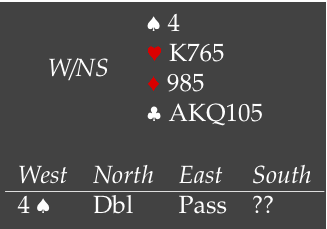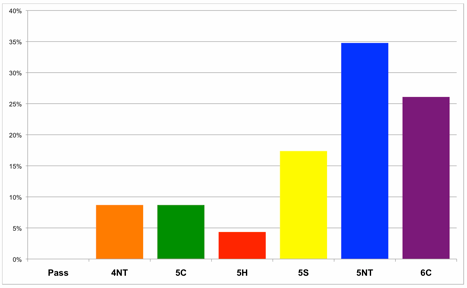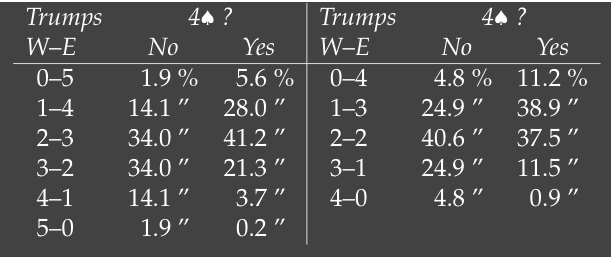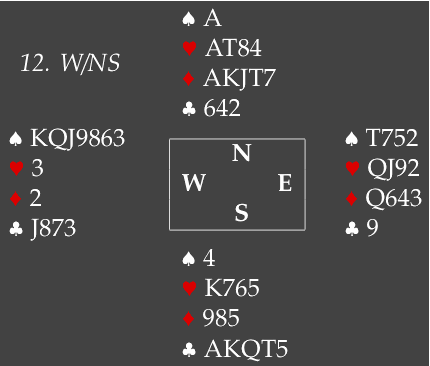
 A couple of things found their way into my mailbox this week.
A couple of things found their way into my mailbox this week.
First, there was this flyer for the Interbridge Team Tournament on June 9, at “de Denktank” in Arnhem. The short version: 9:45 start, 7 7-board rounds of swiss, 80 euro/team, 600 euro first prize. Click on the picture on the left or here to download the flyer. Pre-registration is required, by mailing or calling Ruurd at info@bridgearnhem.nl or +31-6-15964839, or Peter at +31-6-22215470.

Next, of course, a lot of feedback on the bidding problem I posted on Monday. In case you don’t remember the hand, here it is. Teams, very high level, your turn to bid something:
I predicted votes for pass, 4NT, 5♣, 5♥, 5♠ and 5NT. The readers of this blog added a popular 7th choice: 6♣. Here is an overview of the results:

My ideas about the various bids:
- 5♠ and 5NT: I’ve grouped these 2 as most of the people who voted and entered a comment, seem to use this bid for the same purpose: “Pick a slam”, showing 2 places where responder wants to play. Partner will bid the lowest suit he prefers, if that happens to be 6♦, the plan is to correct to 6♥. That sounds like a decent plan with one flaw. Partner can also double 4♠ on something like a 2-3-5-3 or 2-2-6-3 shape. Over 6♦, a correction to 6♥ is not going to work out well. Also, you basically commit your side to the 6 level, 7 is out of the questions. However, I have to admit that I had decided on 5NT while kibitizing Louk Verhees at the table.
- 4 NT: Intended as “pick a suit”. The same arguments as for 5♠/NT apply, with one practical difference. If partner bids clubs, you can make a slam try yourself and have partner re-evaluate. 4NT was the option chosen by 2 of the world champions holding this hand. The rest of the auction was quite different though. At table 2, south made a forcing pass over 5♠, then respected his partner’s choice. At table 3, south blasted into slam. The remainder of the auction is interesting too, the double over 6♥ showed that west wanted to save over 6♥ unless partner had a good reason not to do so. As we’ll see in a moment, east had such a reason.
- 5♣: Your best suit, but short on values. Remove a few honors and you’d still bid that.
- 5♥: Not surprisingly, this did not attract many votes. At imp’s, the goal is to find the best trump suit, not the best paying suit, as the difference between +600 and +650 is small.
- Pass: I think this is too passive, even though the world champion at table 1 actually bid this. The main argument: your hand is much better than average and west knew what he was doing when he opened 4♠. By playing 4♠x, you play the contract that west wanted to play. Sure, you will score plus every once in a while, but is it sufficient.
- That leave one bid, 6♣: It sounds a bit unilateral, but the more I think about it, I think it is a reasonable choice. 6♣ figures to be right on values and you are very likely to have a 5-3 fit. With a real 2-suiter, partner won’t double 4♠ but bid 4NT as some sort of 2 suited take-out. That makes his shape something like 1-4-5-3, 2-4-4-3, or such. In all those case, 6♣ looks quite playable.
There is one other argument in favor of 6♣ that I didn’t realize at the time and that is the trump split. With 7 or 8 spades on your left, the probability of another suit breaking badly increases. That is something that can be checked with a dealer simulation. The summary: if our side has an 8 card trump fit somewhere and we know nothing about the opponents’ hands, the probability of 4-1 or 5-0 trump split is about 16%. If we factor in the 4♠ bid, the probability of trumps being 4-1 or 5-0 on your right (that is, in the hand that did not bid 4♠) increases to 33%. The same happens with a 9 card trump fit. Full results in the table below: the first 3 columns show the trump break for an 8 card fit without and with the 4♠ bid, the next 3 for a 9 card fit, again with and without the 4♠ bid. Now, obviously, a bad trump split is easier to handle if the long trumps are in front of you. That will be the case with 6♣, not with 6♦/♥.


So, my vote goes to 6♣ and just to show what happens when real life kicks in, here is the full hand. The result at the table were 4♠x, -1, for the anchor table, losing 5 against table 2 (5♠x,-2) and winning 11 against 6♥xx, down 2 at table 3. The east player at table 3 indeed had a good reason not to take the save.
And finally, I received a couple of mails about a hand I discussed late last month. I’ll discuss those one in a next blog. Stay tuned...
